
Rediscovering Japan

Rediscovering Japan
Travel (North Ibaraki, Hitachinaka, Mito) (Fukuroda Falls/Nemophila)

by tomizuta
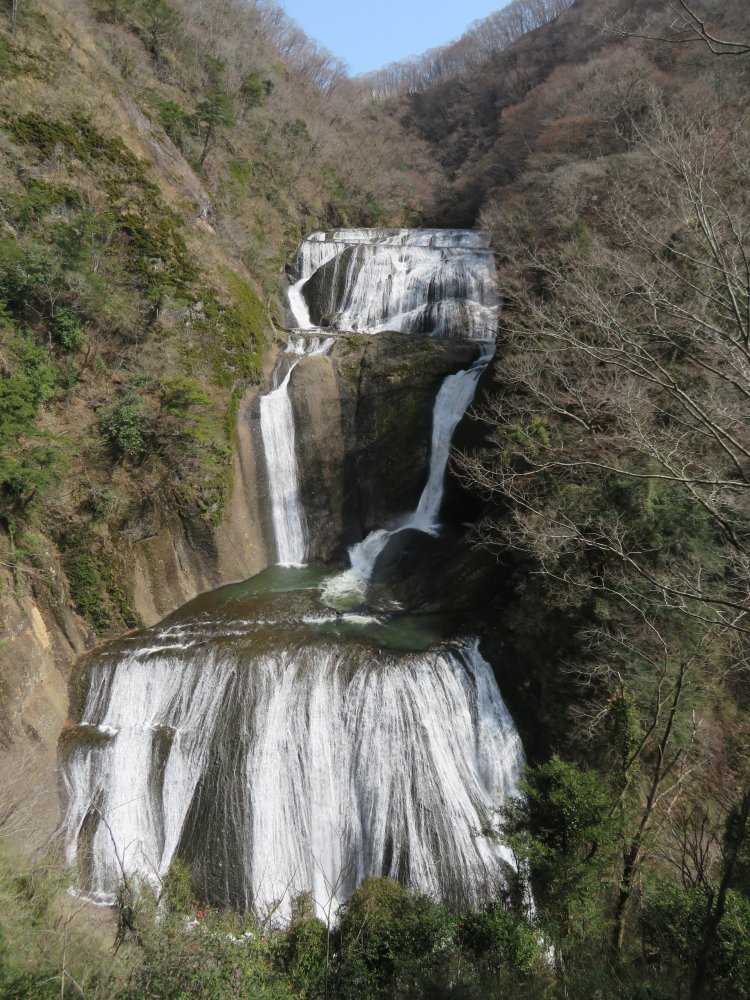
Fukuroda Falls has a height of 120 meters, width of 73 meters and 4 drops.
According to pre-Covid 19 statistics on travelers staying at hotels and ryokans, Ibaraki Prefecture was one of the lowest ranking prefectures. This can to some extent be explained by its proximity to Tokyo, as people from the Kanto urban areas tend to make only day excursions to the area, but also the lack of prominent sightseeing spots. In my case, I had only stayed one night in the past in Ooarai on the east coast. One place I had long wanted to visit was the Fukuroda Falls, known as one of three largest waterfalls alongside The Kegon Falls in Nikko and Nachi Falls in Wakayama Prefecture. With the 6th wave of Covid 19 still at 50,000 new infections per day level, I planned a 3-day excursion to Ibaraki Prefecture, including Fukuroda Falls in early April 2022. It is about a 200 kilometers drive from Chiba to Fukuroda Falls via Mito City, the capital of the prefecture. I did not know until this occasion that northern Ibaraki is one of the largest soba growing areas, particularly known for its soba variety, Hitachi Akisoba (Hitachi is the old name of the Ibaraki area). We tried this soba for lunch at a roadside soba restaurant in Hitachi Ota City in-between Mito City and the Fukuroda Falls. It was shortly past noon on a Wednesday, and the car park was almost full, but luckily, we were promptly shown to a table. Judging from the license plates, it appeared that the majority of the guests were locals.
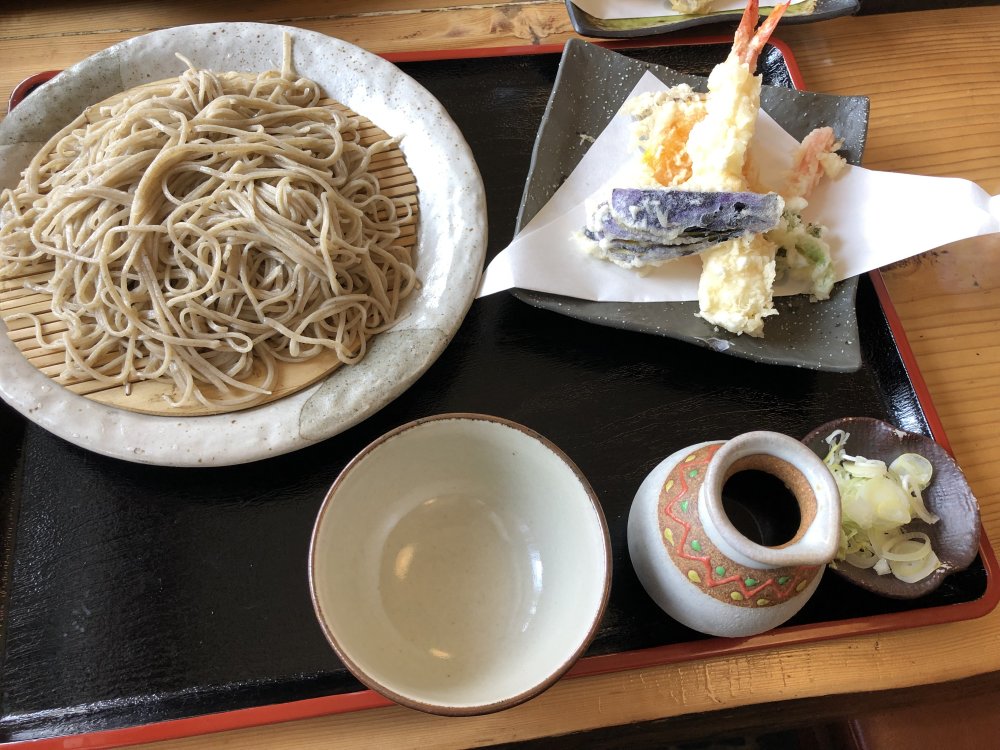
I did not know until this occasion that northern Ibaraki is one of the largest soba growing areas, particularly known for its soba variety, Hitachi Akisoba (Hitachi is the old name of the Ibaraki area). I chose a cold tenzaru-soba (soba noodles and tempura to enjoy in a dip sauce).
I chose a cold tenzaru-soba (soba noodles and tempura to enjoy in a dip sauce) together with a lotus root tempura from their seasonal menu. The hand-kneaded soba was relatively short with a pleasant aroma and met my taste. I found the lotus root (coming from Lake Kasumigaurs), which was fresh and firm, was also quite good. The prices were very reasonable with the tenzaru priced at 1,300 yen.
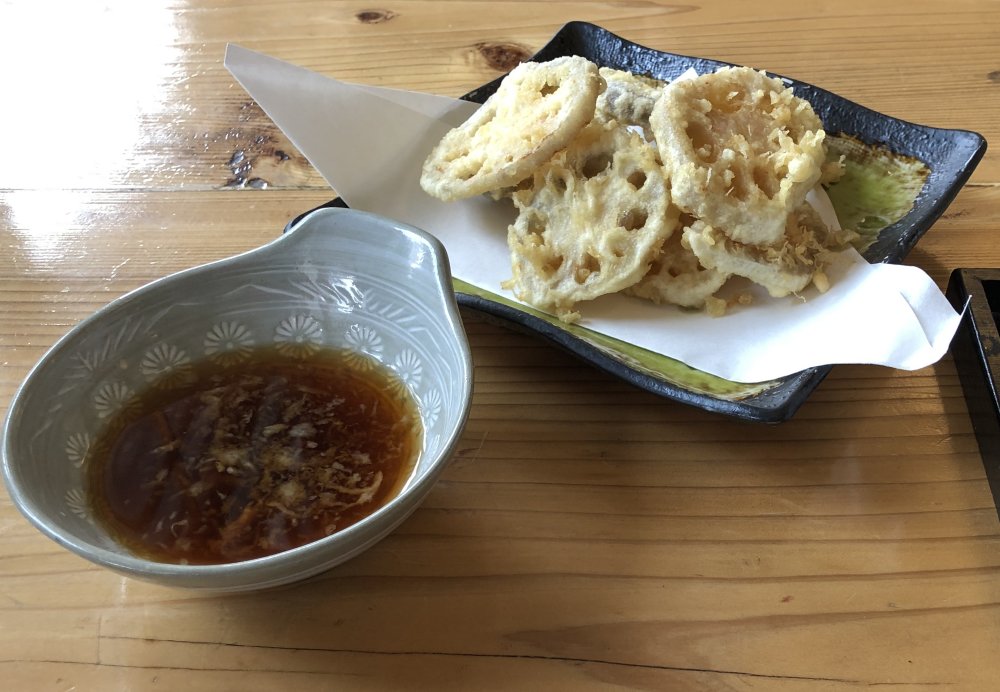
I found the lotus root (coming from Lake Kasumigaurs), which was fresh and firm, was also quite good.
We reached Fukuroda Falls shortly after 1pm. As we approached the falls,
there were many car parks with attendants inviting us to park. We didn’t
wish to waste our time searching for cheaper car parks, or ending up in
a car park far from the falls. We went past some car parks and parked in
one close to a river which belonged to a gift shop. We were told that the
parking fee of 500 yen would be refunded should we spend 1,500 yen or more
at the shop. Although it happened that we had chosen one closest to the
falls, it was still a ten minutes’ walk along the river to the entrance
and admission office. We paid the admission fee (300 yen per person) and
entered the tunnel entrance to the waterfall.
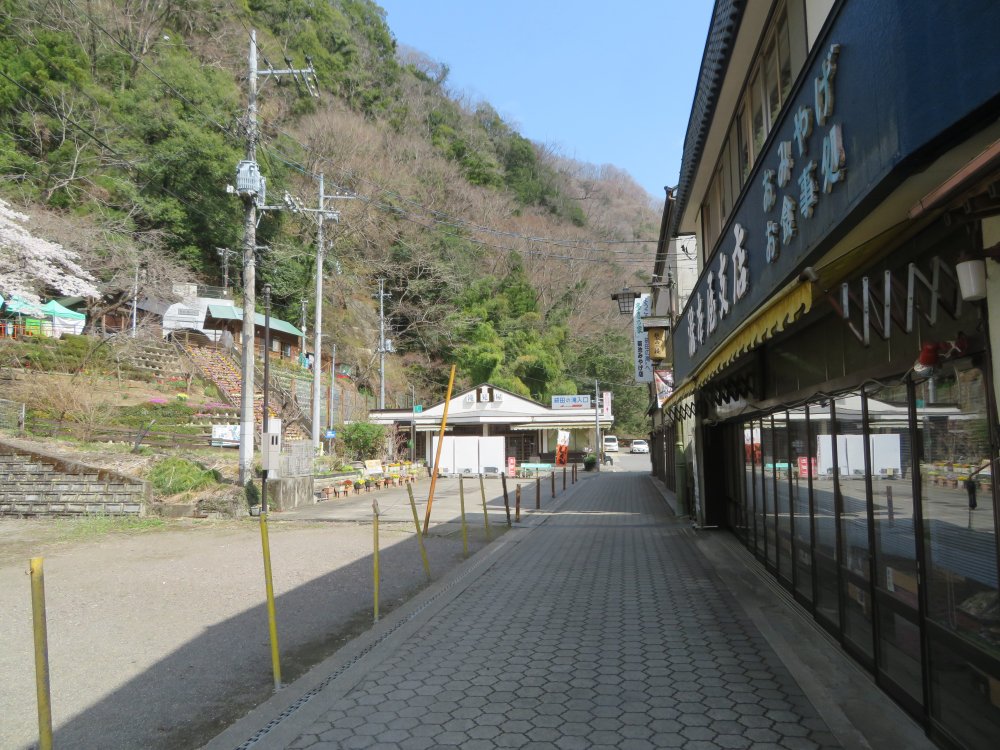
We walked about ten minutes along the river to come to the entrance and admission office (seen at the very end).
Fukuroda Falls has a height of 120 meters, width of 73 meters and 4 drops. Of the other 2 famous warefalls in Japan, Kegon Falls in Nikko has a height of 97 meters, width of 7 meters in one drop, and Nachi Falls in Wakayama has a height of 133 meters width of 13 meters in one drop. As seen from the numbers, Fukuroda Falls is much wider, although dwarfed still much smaller globally compared with Victoria Falls with a width of 2 kilometers. The beauty of Japanese waterfalls lies more in its picturesque location in the mountains, blending in the mountain forest and beautiful scenery particularly in the Autumn season as the leaves turn color. At the end of the tunnel on the right was a balcony area allowing a view of the falls from close proximity.
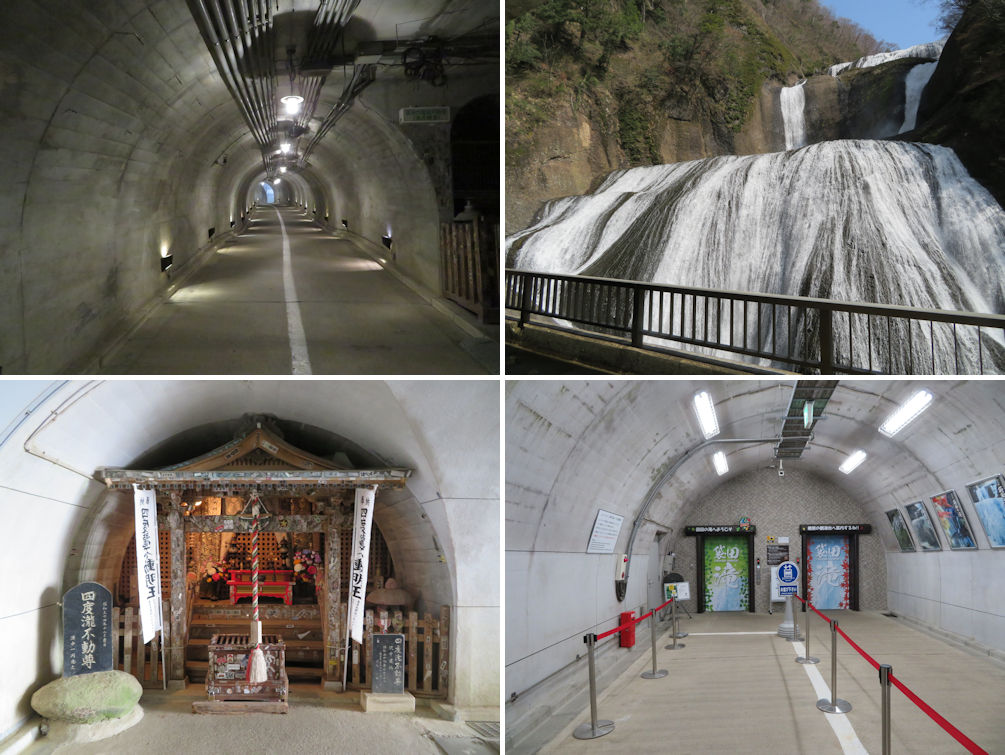
The tunnel leading to the elevator to the top observation area (upper left), balcony area allowing a view of the falls from close proximity.(upper right), Yodotaki (four drop waterfall) Fudoson, an altar dedicated to a Buddhist deity (Fudoson) closely linked to Buddhism/Shintoism spiritual training in mountains and waterfalls to dispell earthly desires (lower left) and the elevator leading to the top (lower right).
We took the elevator on the right to the top observation area. An attendant greeted us at the top, who I assumed was there to ensure not too many people go up the stairs to the top level at the same time. Luckily, there were not that many people up in the observation area. The falls was much grander than I had expected. The view of the waterfall blending beautifully in the mountains and valley was very rewarding.
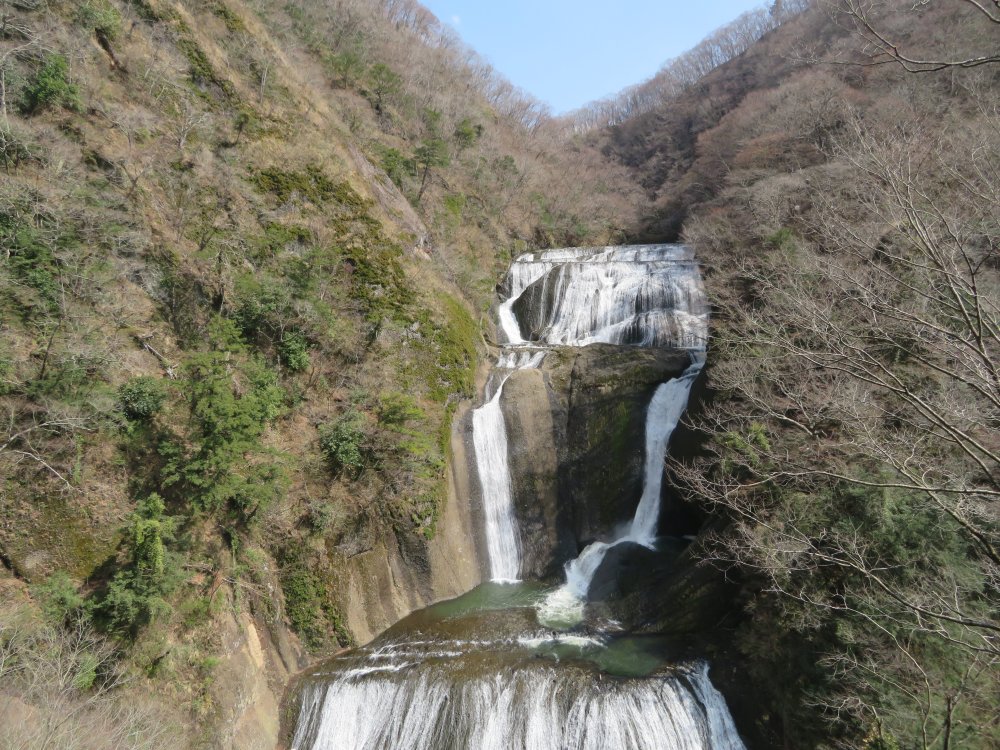
Fukuroda Falls has a height of 120 meters, width of 73 meters and 4 drops.
We took the elevator back to the tunnel and left by a separate entrance leading to a suspension bridge over the river. We went over the bridge to the opposite northern side of the river and back to the car park. We purchased two local specialities, soba noodles and konnyaku (rubbery and healthy cake produced from yam roots) at the gift shop and received refund of the parking fee. The konnyaku usually stewed with potatoes and fishmeal balls in a Japanese dish called oden, was promoted to be enjoyed as sashimi.
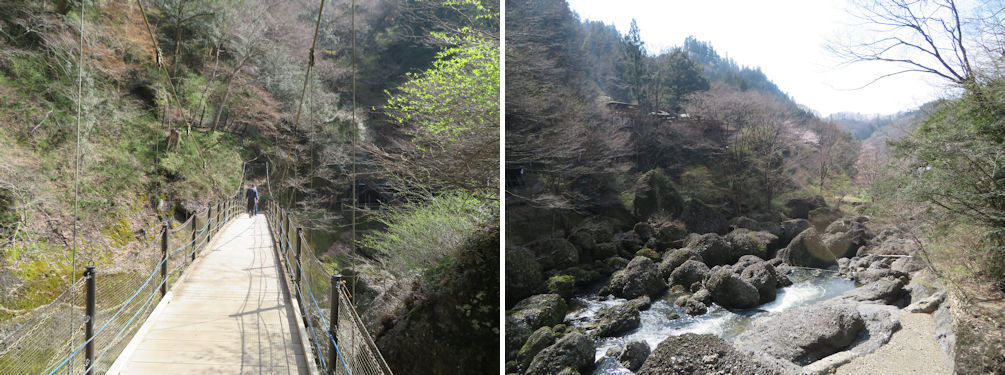
The suspension bridge to the northern side of the river (left), Taki River flowing west to finally join Kuji River whivh flows east to the coast (right).
We stayed at an onsen ryokan not far from the falls. As we went into the car park, an attendant approached us asking if we needed any assistance with our luggage which we did not. It appeared we were one of the first guests arriving on the day. We checked in and went up to our room, which was a quite spacious tatami room with a view of the river and mountains on the back. I enjoyed an early bath in their basement floor public onsen bath with an outside bath, which I had entirely to myself. Dinner was served in the room and with many local delicacies including sashimi of konnyaku, grilled rainbow trout and Hitachi beef shabushabu.
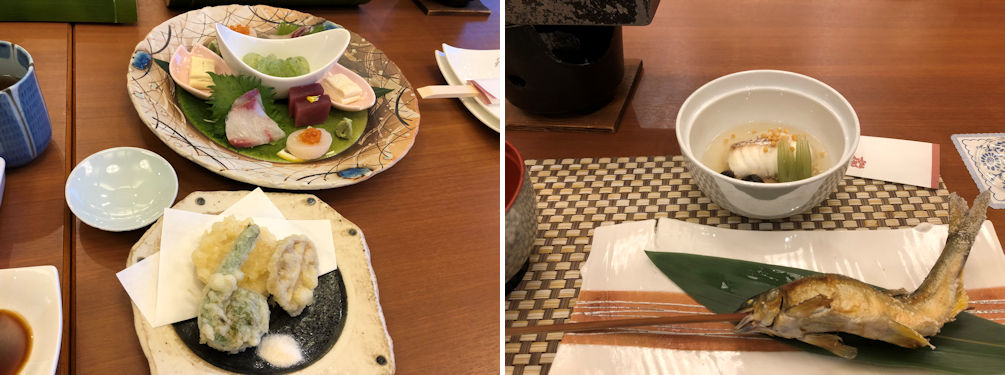
Dinner was served in the room and with many local delicacies. The sashimi and tempura including sashimi of konnyaku (in a bowl) among other fresh seafood (left) and grilled rainbow trout (right).
We left early next morning to first Ryujin-kyo Valley about 30 kilometers south of Fukuroda Falls and famous for its suspension bridge over the valley as well as as a bunjee jumping site. The admission fee to the suspension bridge was 320 yen per person. The suspension bridge used to be the longest pedestrian suspension bridge with a length of 375 meters until overtaken by Yume suspension bridge (390 meters) in Kuju (Ooita Prefecture) and Mishima suspension bridge (400 meters) in Mishima (Shizuoka Prefecture) in 2006 and 2015 respectively. Ryujin-kyo and Fukuroda Falls are located along a fault called Tanagura Fault stretching 60 kilometers to Tanagura in Fukushima Prefecture. According to an explanation provided at the other side of the bridge, “the Japanese Island was separated from the Eurasian continent by this fault about 15 million years ago”. You can command a spectacular view of the Ryujin Valley and the Ryujin Dam from the bridge. The bridge is quite sturdy so that visitors nervous of swaying can enjoy a walk across.
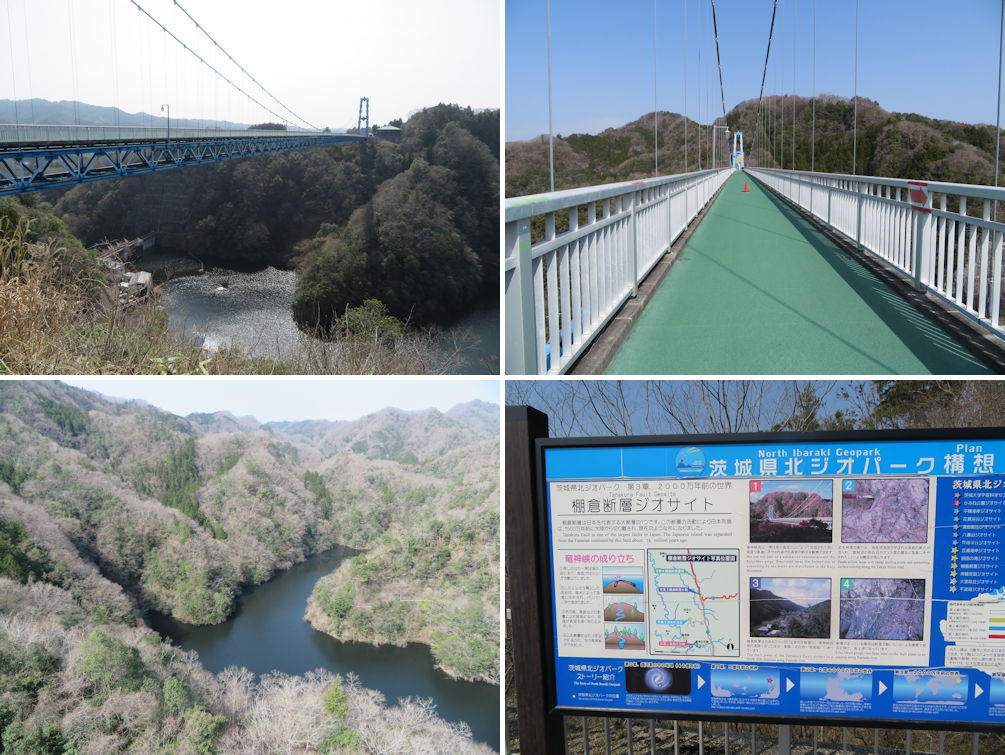
The suspension bridge seen from the opposite side. It is 375 meters long (upper left). The bridge is quite sturdy so that visitors nervous of swaying can enjoy a walk across (upper right). View of the valley from the bridge (lower left) and an interesting explanation (with English) of the Tanagura Fault was provided at the opposite side (lower right).
We drove southeast towards the seaside to our next destination, Hitachi Seaside Park, a national park in Hitachinaka City. As the English website of the park says, the park “offers beautiful flowers in its well-kept, large gardens throughout the year”. It is particularly known for its beautiful beds of nemophila (baby blue eyes). The nemophila was at 30% bloom when we visited the park in early April. It’s a huge park of 2 million square meters (500 acres) with many car parks. We parked in a car park on the east side close to the sea. We paid the parking fee of 500 yen and admission fee to the park of 210 yen for those above 65 (normal fee 450 yen). Following the map provided, it took us ten minutes to arrive at the nemophila beds. Visitors were not that many, and we enjoyed a pleasant walk along the beds up and down the hill slopes. There were food stalls and flower shops in the square at the bottom of the nemophila beds.
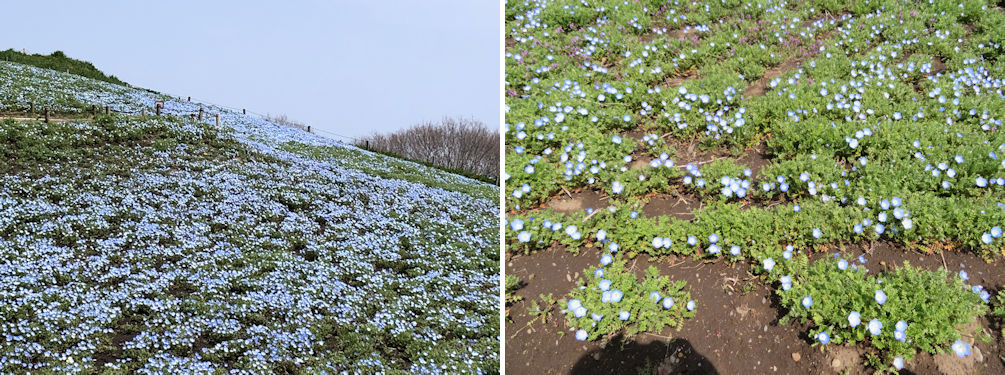
The nemophila (baby blue eyes) was at 30% bloom when we visited the park in early April.
We had lunch on our way for a second visit to the Bakumatsu and Meiji History Museum in Ooarai town at a seafood barbecue restaurant to enjoy some local seafood. We did not wish to barbecue ourselves and ordered a sweet broiled anago (conger eel), fried oysters and a crab miso soup which were served in generous portions. The Ooarai coast is known for its tasty anago.
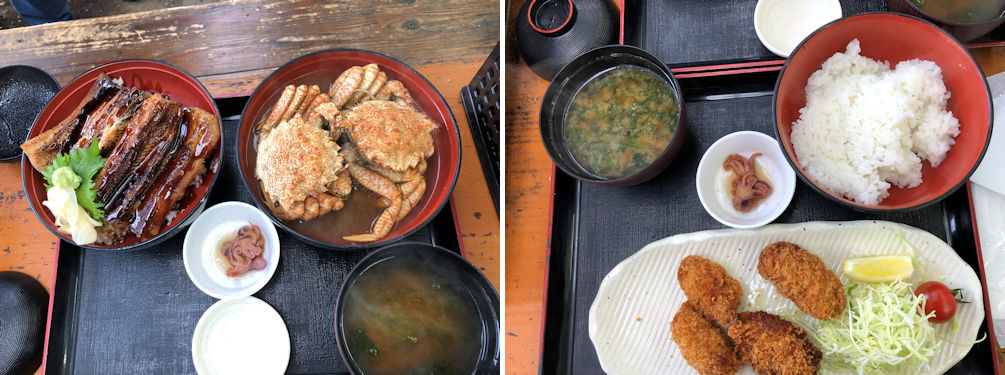
The broiled anago with crab miso soup (left) and the fried local oysters (right).
Before checking in at the hotel in central Mito, we paid a brief visit to Ibaraki Prefectural Archives and Museum. This is a prefectural museum located about three kilometers west of Mito Station and north of Kairakuen famous for its plum blossoms. As introduced in the other article on Ibaraki Prefecture, most areas were traditionally known as Hitachi and as an Edo era feudal domain, Mito-han. The castle was in Mito City and the feudal lords were Tokugawa, one of the three prominent Tokugawas other than the shougun, alongside Owari (Nagoya) and Kishuu (Wakayama). The 15th and last Tokugawa shogun Yoshinobu came from the Mito Tokugawa Family. The museum houses objects and treasures donated by a descendant of the Tokugawa Family. It has a regular exhibition room showing the history of Ibaraki from pre-history to modern ages, and runs periodic special exhibitions centered around the objects donated by the Tokugawa Family. The museum offers guided tours during periods with no special exhibition (which is quite rare). I missed the opportunity on this occasion as they were running a special exhibition on Meiji era dressing in the imperial court. On the museum grounds they have a couple of relocated historic buildings. The museum displays. although interesting did not add much in particular to what I already knew, but the relocated elementary school building which you can enter triggered some nostalgic memories of the elementary school I went to.
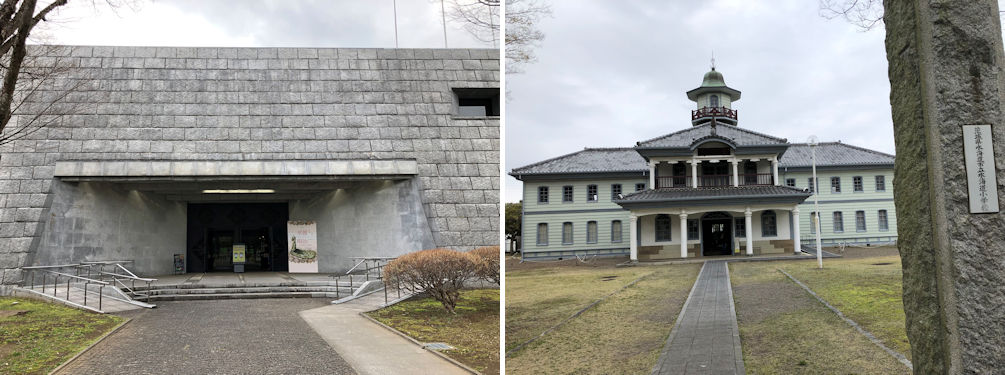
Ibaraki Prefectural Archives and Museum (left) and the relocated western style elementary school building built in 1881 (right).
The following day, we set out to explore parts of Mito City that we skipped on our previous visit. We first took a walk around the castle area, which was undergoing reconstruction work on our last visit and we knew had been completed. The new academic year had started and it appeared that entrance ceremonies were being held at schools. As is the case in many castle towns, a large part of the castle grounds now house schools from pre-school to high schools. We took a moment to admire the resurrected Ootemon (main gate) of the former castle. It was a beautiful day, and children in brand new uniforms were taking pictures with their parents probably before attending the entrance ceremonies.
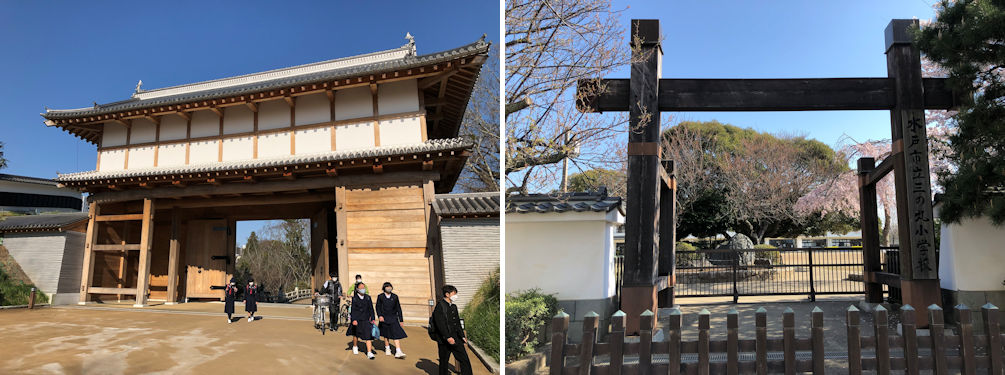
The resurrected Ootemon (left). A large part of the castle ground now house schools. Sannomaru Elementary School using an old gate for a side entrance (right).
Our last visit was to the Tokugawa Museum. As explained on the museum English website, this museum opened in 1997 is run by the Mito Tokugawa Family, “to preserve and exhibit the arts and the crafts as well as the documents passed down in the family”. Indeed they had an awesome collection of crafts and documents dating back to the 17th century and including a classic British car used by the family. Although it is understandable how precious the displays may be, you may not be happy to pay an admission fee of 1,800 yen, unless you have a real interest in the lives and family treasures of the Tokugawa Family.
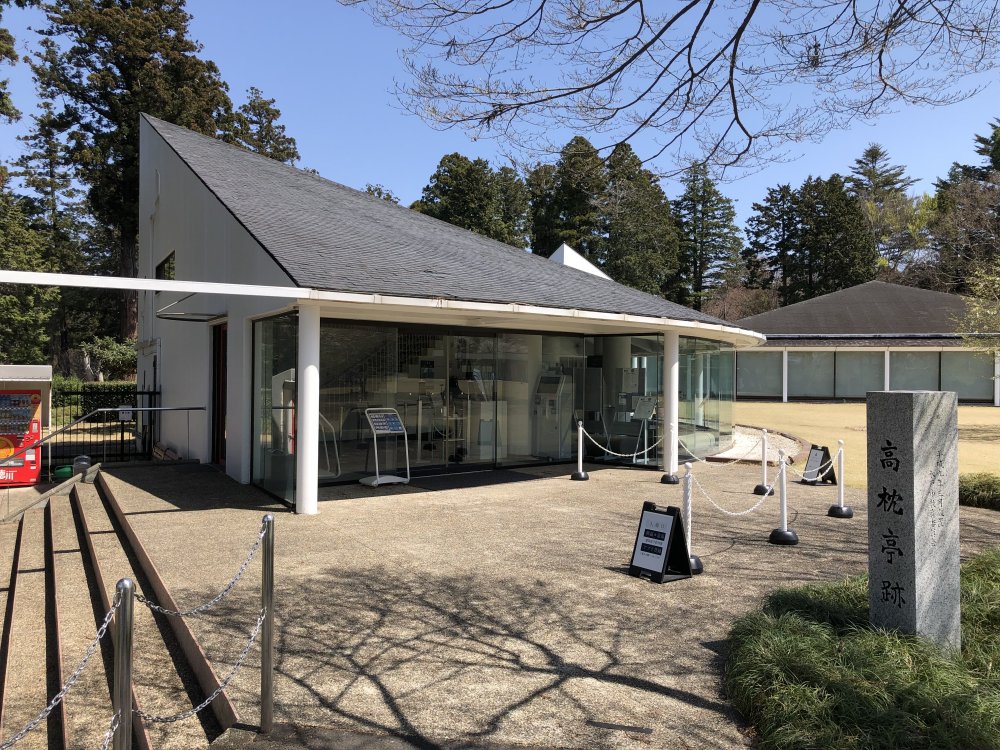
The Tokugawa Museum opened in 1997 and run by the Mito Tokugawa Family.
I did not forget to purchase a local sake on this occasion. The Kujinoyama honjouzou.
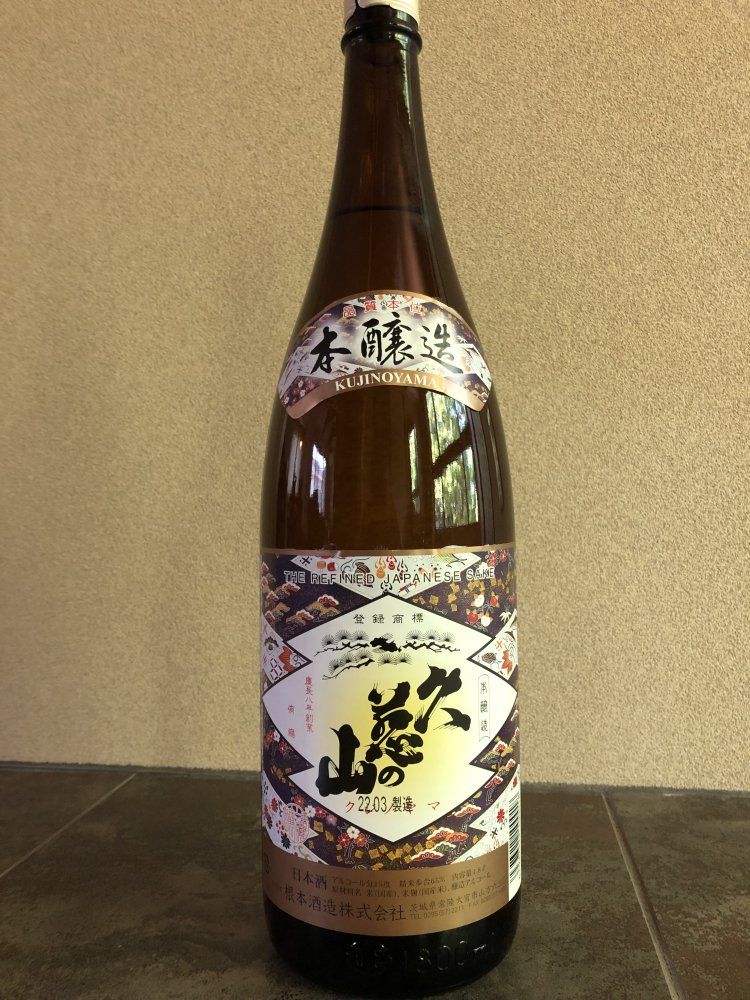
The Kujinoyama honjouzou.